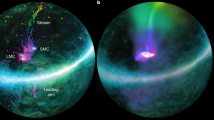Abstract
A simple sticky-particle numerical model has been developed in order to check whether extended structures of gas created due to the dynamical evolution of the Galaxy and the Magellanic Clouds system can be explained as remnants of a tidal interaction. Influence of dissipative nature of gaseous medium has been taken into account. The most remarkable features are: the Magellanic Stream, the common HI envelope surrounding both the LMC and SMC and the bridge extended between the Clouds. In contrast to previous works of Murai and Fujimoto (1980), Gardiner et al. (1994) and H and Rohlfs (1994) no presumptions were done on the actual galactocentric velocities of the Magellanic Clouds. The mean values of the LMC and SMC velocity vectors obtained from the Hipparcos proper motion measurements (Kroupa and Bastian, 1997) were used in order to verify whether they allow to reproduce the observed HI distribution. Numerical simulations showed that tidal forces are really significant for the evolution of extended structures such as the Magellanic Stream but this approach becomes unsufficient for the internal regions of galaxies where self-gravity and dissipative properties of the gas cannot be neglected. More precise proper motion measurements are urgently needed.
Similar content being viewed by others
References
Chandrasekhar, S.: 1943, Dynamical friction. I. General considerations: the coefficient of dynamical friction, Astrophys. J. 97, 255.
Gardiner, L.T., Sawa, T. and Fujimoto, M.: 1994, Numerical simulations of the MPart One ‐ Orbits of the Magellanic Clouds and the global gas distribution, Mon. Not. R. Astron. Soc. 266, 567.
Heller, P. and Rohlfs, K.: 1994, The dynamical evolution of the Magellanic System, Astron. J. 101, 743.
Jungwiert, B. and Palouš, J.: 1996, Multiple gas rings in disk galaxies: computer simulations with dissipative collisions, Astron. Astrophys. 311, 397.
Kroupa, P. and Bastian, U.: 1997, The Hipparcos proper motion of the Magellanic Clouds, New Astronomy 2, 77.
Murai, T. and Fujimoto, M.: 1980, The Magellanic Stream and the galaxy with a massive halo, Publ. Astron. Soc. Japan 32, 581.
Palouš, J. and Zheng, J.Q.: 1998, A simple mass-distribution model of the Milky Way (Preparing a dynamical study of Gould's Belt), Proceedings of the 29th Conference on Variable Star Research, 7th‐9th November 1997. Brno, Czech Republic, p. 93.
Schwarz, M.P.: 1981, The response of gas in a galactic disk to bar forcing, Astrophys. J. 247, 77.
Van den Bergh, S.: 2000, The Galaxies of the Local Group, Cambridge University Press.
Author information
Authors and Affiliations
Rights and permissions
About this article
Cite this article
Ružčka, A. The system of the Milky Way, LMC and SMC. Astrophysics and Space Science 284, 519–522 (2003). https://doi.org/10.1023/A:1024068613813
Issue Date:
DOI: https://doi.org/10.1023/A:1024068613813




